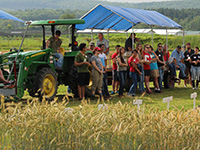Home | Unit 2
Overview
Your group practice different methods of growing plants without soil, with a focus on food crops, then work in small groups to develop a plan for a simple, sustainable, soilless food garden to use in a school or community setting. Introduction to this activity will be though hands-on discovery of how these systems work.
Skill Level
Beginner, Intermediate
Learner Outcomes, Youth will:
- Observe and reflect on how changing climate conditions affect how plants grow in the garden
- Explore alternative methods of growing plants and food in a controlled environment
- Practice growing plants hydroponically or by other soilless methods
- Become familiar with alternative methods farmers use to address climate change issues, and how to adopt such changes within the food system
Education Standards
- NS.K-4.3 Life Science: Characteristics and Life Cycles of organisms, Organisms and environments
- NS.5-8.3 Life Science: Diversity and adaptations of organisms
- T4.3-5.b: Describe how technology helps farmers/ranchers increase their outputs (crop and livestock yields) with fewer inputs (less water, fertilizer, and land) while using the same amount of space
- T4.3-5.d: Provide examples of science being applied in farming for food, clothing, and shelter products
Success Indicators
Youth understand there are alternatives to traditional agricultural methods to grow food crops.
Life Skills
Healthy lifestyle choices, goal setting, planning, wise use of resources, resiliency
Time Needed/Materials/Space
Varies depending upon activity choice, introductory Reference: Growing Food in Changing Climate Conditions FAQ’s
Suggested Group Size
12-15 or more
Acknowledgments
Cornell Garden-Based Learning Library: Growing Vegetables, authored by Cornell Cooperative Extension County Horticulture Educators.
Introduction
Climate change and a warming world has a direct consequence on our gardening and farming practices. Farmers, gardeners, schools, and large companies have looked to growing food indoors in controlled conditions for greater results. There are many methods of growing food without soil, using hydroponics, aeroponics and aquaponics and youth will explore how groups and organizations grow and harvest food using these methods to feed large and small groups of people. Your group will do hands-on practice of different methods of growing plants without soil, with a focus on food crops, then work in small groups to develop a plan for a simple, sustainable, soilless food garden to use in a school or community setting. Introduction to this activity will be though hands-on discovery of how these systems work. Choose one or more of the recommended 4-H, National AG in the Classroom, or other curricula in the suggested activities, Variations or Learn More sections that are appropriate for your group’s skill level.
Opening Questions: In what ways have you seen changing climate conditions affect how food grows in our garden? What ways have you seen farmers grow food without soil? What did they grow? For whom who was the food harvested? Have you grown plants without soil? Were they healthy and if not, what do you think you could do differently?
Background Information
Before the Activity: Leaders will research the different curriculum listed here and select one or more activities for your group to do before following the next steps of the activity. Purchase and prepare all the materials needed for the activities you choose. Refer to the accompanying Growing Food in Changing Climate Conditions FAQ’s to open the discussion on how we need to modify existing gardening practices and adopt and modify alternative methods and to address changing climate conditions. Adapted from Cornell Garden-Based Learning Library: Growing Vegetables, authored by CCE County Horticulture Educators.
Suggested Activities
4-H Stem Lab Bean in the Bottle: Exploration of plant lifecycles, indoor gardens and what plants need to survive
National Agriculture in the Classroom:
- Test Tube Hydroponics is an investigation of the importance of nutrients for plant growth and discover soilless growing by growing and observing plants in a test tube hydroponic system.
- Exploring Aquaponics: Youth identify the basic needs of plants and fish and engineer, assemble, maintain, and observe a small-scale aquaponics system that meets plant and fish needs.
- National Agriculture in the Classroom: “What? No Soil? After learning the five basic requirements of plant growth, youth build and maintain hydroponic units from soda bottles.
Let’s Do It!
- Ask opening questions. Use the Growing Food in Changing Climate Conditions FAQ’s to lead further discussion on how traditional growing methods may be difficult due to climate change.
- Continue the conversation with: “Imagine growing food on a large or small scale, for the lunch program at your school or for a local food pantry”.
- Explain that you will be exploring different soilless methods of growing food, and how groups and organizations are feeding people
- Follow the procedures of one or more of the suggested activities.
Talk It Over
Reflect
Use a plant journal to keep track of progress and observations while growing plants in alternative ways. What examples of science are being applied in farming for food, clothing, and shelter products?
Apply
How do you see farmers/ranchers using these technologies to increase their crop and livestock yields)with less water, fertilizer, and land while using the same amount of space? How does this address the issues we face due to climate change?
Variation
National Agriculture in the Classroom: Simplified Floating Hydroponics: a long-term project demonstrating soilless growing methods
References
- “Growing Food in Changing Climate Conditions Q & A’s” adapted from Cornell Garden-Based Learning Library: Growing Vegetables, authored by CCE County Horticulture Educators.
- National Agriculture in the Classroom
Learn More
- 4-H Leader’s Guide: Grow with the Flow
- Climate Change Education, Stanford Earth School of Earth, Energy and Environmental Sciences
- Connected Science Learning: Seeding the Future: Blending Urban Gardening with Community Outreach and STEM Learning, National Science Teaching Association
- FarmFlavor: How Walt Disney World’s Farm Grows the Most Magical Produce on Earth

Vertical farming using aeroponics at Living with the Land at Walt Disney World, EPCOT. Photo by Donna Alese Cooke
- Foodspan, Teaching the Food System from Farm to Fork
- National Agriculture in the Classroom, search for lessons relating to the topic: e-Learning Resources and Agricultural Literacy Curriculum Matrix
- Sustainable Agriculture Research and Education: Introduction to Climate Resilience in Agriculture
- The Green Bronx Machine is a non-profit started by high school teacher Stephen Ritz (see his curriculum and lesson plans). He teaches students and youth how to grow food and adopt healthy food choices in the classroom and in other spaces using aeroponics (Tower Gardens), and then share the harvest to feed students in schools and families in the community.
- Seton Hall University Science Lessons and Exercises for Tower Gardens: Free CCSS and NGSS aligned lesson plans and learning materials in PDF format. Tower Gardens teach cross-curricula topics and healthy eating
- U.S. Climate Resilience Toolkit: A powerful tool for exploring climate impacts and design solutions on a national scale.
- USDA National Agricultural Library resources on vertical farming, aquaponics, aeroponics and hydroponic farming









